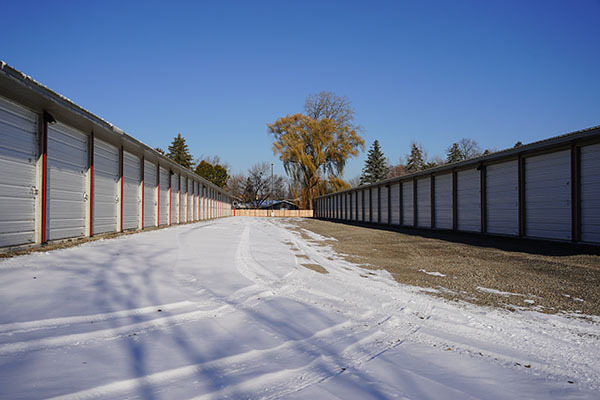If your storage
facility is not climate-controlled or indoor, you will need to get your
belongings ready for freezing temperatures and potential water damage. Ideally,
you will prepare your furniture for storage before you move in, but if you did not,
there is still time to take some preventive steps to get specific items ready
to sit in storage for the winter ahead.

It can be hard to
know what constitutes a “temperature-sensitive” item without having experienced
the loss of something precious due to prolonged storage durations. Outta Sight Storage has seen it all, so we have compiled a
sample list to help you think about how your most treasured items are currently
stored, or will be stored, in your storage space.
1. First things
first - clean whatever you can. Storing dirty items can result in mildew, mold,
or corrosion forming. If you plan on repacking or reorganizing things in your
existing self-storage unit before winter settles in, this will be a perfect
opportunity to dust and clean things before placing them into new boxes or
bins. Before storing vehicles, lawn mowers, or machinery, clean and
winterize it according to manufacturer recommendations.
2. If you are
storing a grill for the season, make sure you clean it before taking it in, so
you don’t get any critters looking for a winter meal! Rodents and insects often
seek out warm, dry places during winter months. Don’t give them places to roost
in your storage unit! Anytime you leave your packed rental space, make sure you
don’t leave any food or trash in the unit that could attract them, or
accessible materials that could be used to build nests.
3. When possible,
use water-resistant boxes! Cardboard is great for temporarily storing things,
but it cannot withstand moisture and temperature fluctuations without losing
structure. Plastic bins are great for self-storage because you can see what’s
inside them, but also because they will better protect your belongings! When
buying bins to be stored long-term or during winter, keep in mind that the type
with fold-in lids will not protect the contents from water intrusion, in the
event your storage unit has a leak. Everything that can’t fit into a bin should
be covered to prevent easy access for pests and to provide insulation from the
cold. Using blankets or towels for this is a good idea.
4. Use pallets,
shelves, or wooden boards to keep your belongings off the ground. It’s always a
good idea to do this, but it is essential during the winter! The ground gets
damp, especially with an outdoor unit, and moisture can seep up from the floor.
Any cardboard boxes, furniture, or items left on the floor will be susceptible
to this moisture damage.
Antiques – How you wrap and protect valuable
heirlooms and antiques will depend on the item itself. Silver may need to be
treated, glass domes or preserved material may need protection against
humidity. If you can, do a little research on the items you’re most concerned about
protecting to learn which storage strategies are best for them.
Artwork –
Specifically, paintings. Prints and posters can survive the cold weather, but
not moisture or water damage. Canvases and paint are prone to cracking or
peeling with harsh temperature changes. Pack your artwork as carefully as you
can and keep it away from vents and doors.
Bikes – Keep tires inflated, and either hang them
or turn them upside down to rest on the seat and handlebars in your storage
space.
Electronics &
Batteries – Due to their contents,
batteries may not handle extreme temperature fluctuations well. We recommend
wrapping these carefully and storing them so that they are safe from moisture.
There is certainly an art to storing electronics and valuables for long periods in self-storage, so your
default should be to look up best practices for the items you’re most unsure of
or most concerned about storing safely!
Mattresses – Wrap mattresses in plastic to prevent
rodents from tearing holes and finding a cozy place to nest.
Musical Instruments – Reeds and pads need to be protected from
moisture and extreme temperature fluctuations. Store your instrument in a hard
case, keep it away from vents and doors, and of course, store it off the
ground.
Vinyl Records – Vinyl is best stored upright, not stacked,
to prevent warping from temperature changes.
Wood, Wicker, and
Leather Furniture – Natural
materials can warp or crack with extreme temperature and humidity changes. We
recommend storing furniture that is vacuumed and treated, fully dried, and
covered with moving blankets or old sheets. Keep in mind that loose plastic
covers can trap moisture and lead to mildew or mold growth.
When you have your
storage space all prepped for winter, think about stopping by whenever there
are extreme weather events like rainstorms or snowstorms to see if any moisture
has found its way in. This will give you an opportunity to potentially recover
items before they freeze or get completely ruined. Look for a
climate-controlled storage facility if you are worried about not being able to
protect your belongings completely.
It's a good idea to review
your storage facility insurance policy to understand which weather-related
risks are covered and which are not. If you don’t have insurance on your rental
space, consider buying an insurance plan to protect your belongings against
unforeseen circumstances. Outta Sight Storage offers tenant protection plans that cover damage from water, hail, and
other natural occurrences. See what units we currently have available if you are ready to store some items for
just the season, or longer!